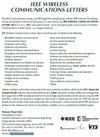Mobility Identification Utilizing Deep Learning for LoRaWAN Location-Based Services
IF 4.6
3区 计算机科学
Q1 COMPUTER SCIENCE, INFORMATION SYSTEMS
引用次数: 0
Abstract
This letter introduces a device mobility identification (DMI) method required for Long-Range Wide Area Networks location-based services, including both mobile and stationary applications. The proposed DMI, trained under various channel conditions, can determine the mobility status of the device in real-time without motion sensors or positioning systems. The training data given to the DMI consisted of packet loss, signal-to-noise ratio, and received signal strength indicator histories recorded at the network server. The performance evaluation provided insights into the generalization capability of the proposed deep learning model for the DMI across both known and unknown environments. Furthermore, the proposed method improves mobility identification performance, achieving an accuracy of 87.30%, as compared with 74.17% of the existing support vector machine approach in an online test assuming a real-time pedestrian monitoring service.利用深度学习为 LoRaWAN 定位服务进行移动性识别
这封信介绍了远程广域网位置服务所需的设备移动性识别(DMI)方法,包括移动和固定应用。所提出的DMI在各种信道条件下进行训练,可以在没有运动传感器或定位系统的情况下实时确定设备的移动状态。提供给DMI的训练数据包括丢包量、信噪比和在网络服务器上记录的接收信号强度指标历史。性能评估提供了对DMI在已知和未知环境中提出的深度学习模型的泛化能力的见解。此外,该方法提高了移动识别性能,在假设实时行人监控服务的在线测试中,与现有支持向量机方法的74.17%的准确率相比,该方法的准确率达到87.30%。
本文章由计算机程序翻译,如有差异,请以英文原文为准。
求助全文
约1分钟内获得全文
求助全文
来源期刊

IEEE Wireless Communications Letters
Engineering-Electrical and Electronic Engineering
CiteScore
12.30
自引率
6.30%
发文量
481
期刊介绍:
IEEE Wireless Communications Letters publishes short papers in a rapid publication cycle on advances in the state-of-the-art of wireless communications. Both theoretical contributions (including new techniques, concepts, and analyses) and practical contributions (including system experiments and prototypes, and new applications) are encouraged. This journal focuses on the physical layer and the link layer of wireless communication systems.
 求助内容:
求助内容: 应助结果提醒方式:
应助结果提醒方式:


